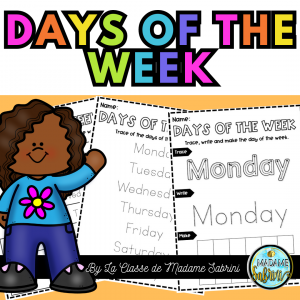This post may contain affiliate links which means I may receive a commission for purchases made through links. I will only recommend products that I have personally used! Learn more on my Private Policy page.
As parents, teachers, and school staff, it’s important to understand how ADHD and autism can present together in students. It can be difficult to differentiate between the two and can lead to feelings of confusion, frustration, and uncertainty about how to best support the student in the classroom and social settings. Through this blog post, we aim to provide insights for parents, teachers, and other school staff to help them better understand what ADHD and autism looks like together in kids, and how to better support students, friends, and family members who may be dealing with both.
ADHD and Autism: What Are They?
As a parent or teacher, it can be challenging to understand the complexities of ADHD and autism, and how they may impact a child’s learning and behavior in the classroom. ADHD (Attention Deficit Hyperactivity Disorder) is a neurodevelopmental disorder that affects a child’s ability to focus, pay attention, and control their impulses. On the other hand, autism spectrum disorder (ASD) is a condition that affects a child’s social communication and behavior.
Both ADHD and autism are developmental disorders that can have a significant impact on a child’s academic and social success. It’s important to recognize that these conditions can present themselves differently in each child. As parents and teachers, it’s essential to communicate openly with each other to help understand and support children who are living with ADHD and autism.
It’s also important to recognize that children with ADHD and autism may require different types of help and support. For example, children with ADHD may benefit from strategies that help them focus and manage their impulses, such as setting clear expectations and offering frequent breaks. Children with autism may need support with social communication, such as practicing conversations and learning how to interpret social cues.
By understanding the characteristics and challenges associated with ADHD and autism, parents and teachers can work together to create effective strategies to help children succeed in the classroom and beyond.
ADHD and Autism: The Overlap
When it comes to understanding ADHD and autism, it’s important to note that these two conditions can overlap. In fact, many children with autism also exhibit symptoms of ADHD. While the exact cause of this overlap isn’t known, researchers have noted some commonalities between the two conditions.
One key area of overlap is in learning and academic performance. Both ADHD and autism can impact a child’s ability to learn in a classroom setting. For example, children with ADHD may struggle with staying focused and paying attention, while those with autism may struggle with social communication and sensory processing.
This overlap can make it difficult for parents and teachers to understand how best to help these children succeed in the classroom. Communication between parents, teachers, and any specialists involved in the child’s care is critical in ensuring that everyone is on the same page and working together to support the child’s unique needs.
It’s also important for parents and teachers to understand that while the overlap between ADHD and autism can present challenges, it also presents opportunities for learning and growth. By understanding the unique needs of each child, parents and teachers can create a supportive learning environment that helps these children thrive.
In the next section, we’ll discuss how ADHD and autism are diagnosed, as well as some common challenges associated with both conditions.
Diagnosing ADHD and Autism
Diagnosing ADHD and autism can be challenging. In many cases, the symptoms of ADHD and autism can overlap, which can make it difficult to identify the underlying condition. This is why it is important for parents, teachers, and other professionals to work together to identify and diagnose these conditions early on.
One key factor in diagnosing ADHD and autism is learning. Children with these conditions often struggle in the classroom, so it is important to identify any issues related to learning and academic performance. Some children with ADHD may have trouble staying focused in class or completing their work, while children with autism may struggle with social interactions and communication.
Parents and teachers should also pay attention to the child’s behavior both in and out of the classroom. Children with ADHD may have difficulty sitting still or following directions, while children with autism may have difficulty with communication and may engage in repetitive behaviors.
Another important factor in diagnosing ADHD and autism is communication. Parents, teachers, and other professionals should work together to identify any issues related to communication. This may involve observing the child’s social interactions, speech patterns, and nonverbal cues.
Once a child has been diagnosed with ADHD and/or autism, parents and teachers can work together to develop strategies to help the child succeed. This may involve modifications to the classroom environment, such as reducing distractions or providing extra support to help the child stay on task. It may also involve working with the child’s healthcare provider to develop a treatment plan that includes medication and/or therapy.
Ultimately, the key to diagnosing and supporting children with ADHD and autism is communication and collaboration between parents, teachers, and other professionals. With the right support and resources, children with ADHD and autism can thrive both in and out of the classroom.
ADHD and Autism in Kids: How They Show Up Together
ADHD and autism can be challenging to differentiate, but they often occur together. Kids with both conditions may exhibit impulsive behavior, inattentiveness, difficulty with social interactions, and sensory issues. In the classroom, these challenges can make it hard for them to focus, follow directions, communicate effectively with peers and teachers, and complete assignments.
Parents and teachers may also notice that children with both ADHD and autism have difficulty with emotional regulation, executive functioning, and sensory processing. For example, they may struggle with transitioning between activities, staying organized, and filtering out sensory stimuli. As a result, they may feel overwhelmed, frustrated, and anxious.
Despite these challenges, kids with ADHD and autism can thrive with the right support. This requires a collaborative effort between parents, teachers, and other professionals. One critical factor is effective communication to ensure that everyone is on the same page and working together to meet the child’s needs.
In the classroom, teachers can help by creating a structured and predictable environment, using visual aids and prompts, providing sensory accommodations, and giving the child breaks and opportunities for movement. It can also be helpful to encourage social skills development through role-playing, peer support, and positive reinforcement.
Parents can play a crucial role in advocating for their child’s needs, partnering with the school team, and providing consistent support and encouragement at home. This may include using positive reinforcement, creating a predictable routine, and seeking out therapy or other resources to help manage the child’s symptoms.
Ultimately, supporting kids with ADHD and autism requires a multi-faceted approach that addresses their unique needs, strengths, and challenges. By working together and using a combination of strategies, parents and teachers can help these kids thrive in the classroom and beyond.
Common Challenges of ADHD and Autism
Children who have ADHD and autism together often experience a range of challenges in the classroom and beyond. One of the most significant obstacles is learning, as both conditions can impact the ability to concentrate, process information, and organize thoughts. Children with ADHD and autism may also struggle to communicate effectively, leading to frustration and difficulty connecting with others.
In the classroom, teachers and parents may notice that children with ADHD and autism have difficulty staying focused, following instructions, and participating in group activities. They may also struggle with changes in routine and unexpected events, leading to anxiety and sensory overload. As a result, these children may require extra support and accommodations to succeed in the classroom and beyond.
Parents and teachers can work together to identify the unique needs of each child and develop strategies that can help them thrive. For example, breaking tasks down into smaller steps, using visual aids, and incorporating sensory activities into learning can be effective strategies. It is also important to create a consistent routine and clear expectations, while providing positive reinforcement and support.
While the challenges of ADHD and autism can be significant, with the right support and strategies, children can learn and grow, and achieve their full potential. By working together, parents and teachers can help children with ADHD and autism overcome obstacles and succeed in the classroom and beyond.
Strategies for Supporting Kids with ADHD and Autism
Supporting children with ADHD and autism can be challenging, but it’s important to remember that there are strategies that parents and teachers can use to help them thrive in the classroom and beyond. Here are some key strategies to consider:
1. Individualized Learning: Kids with ADHD and autism often learn differently from their peers. By individualizing their learning, teachers and parents can create opportunities for success and help them achieve their full potential.
2. Classroom Accommodations: From sensory-friendly environments to accommodations for executive functioning, there are many classroom strategies that can help children with ADHD and autism stay focused, organized, and engaged in the learning process.
3. Parent-Teacher Communication: Building a strong partnership between parents and teachers is crucial when supporting children with ADHD and autism. By working together, parents and teachers can create a consistent approach to support the child’s unique needs.
4. Positive Reinforcement: Celebrate the child’s successes, no matter how small. Positive reinforcement helps build self-esteem and confidence, which can be especially important for children who struggle with ADHD and autism.
5. Encourage Social Interaction: Kids with ADHD and autism can sometimes struggle with social skills. Encouraging positive interactions with peers can help build social confidence and improve overall wellbeing.
6. Help with Self-Regulation: Learning to self-regulate is key to managing ADHD and autism. Parents and teachers can work together to provide support and guidance to help children identify and manage their emotions.
Remember, each child with ADHD and autism is unique, so there is no one-size-fits-all approach. By working together, parents and teachers can create a supportive and inclusive environment that helps all children thrive.
Helping Kids Thrive with ADHD and Autism: Practical Tips for Parents and Teachers
When it comes to supporting kids with ADHD and autism, communication and collaboration between parents and teachers are essential. Here are some practical tips for helping kids thrive in the classroom:
1. Create a structured and predictable environment: Kids with ADHD and autism often struggle with unpredictability and disorganization. Creating a structured routine with clear expectations and schedules can help them feel more in control and less anxious.
2. Use visual aids: Visual aids such as picture schedules, social stories, and graphic organizers can be incredibly helpful for kids with ADHD and autism who struggle with attention and processing information.
3. Offer breaks and sensory support: Sensory issues are common among kids with ADHD and autism, so offering breaks and sensory support can help them regulate their emotions and stay focused in the classroom.
4. Use positive reinforcement: Positive reinforcement can be a powerful motivator for kids with ADHD and autism. Praising them for their efforts, offering incentives, and focusing on their strengths can help boost their self-esteem and confidence.
5. Collaborate with other professionals: Working with other professionals such as occupational therapists, speech therapists, and behavioral specialists can provide additional support for kids with ADHD and autism in the classroom.
6. Educate yourself: Finally, it’s essential to continue learning about ADHD and autism and how they affect kids in the classroom. Attend workshops, read books, and talk to other parents and teachers to gain more insights and strategies for helping kids thrive.
By working together and using these practical tips, parents and teachers can help kids with ADHD and autism reach their full potential in the classroom and beyond.





















